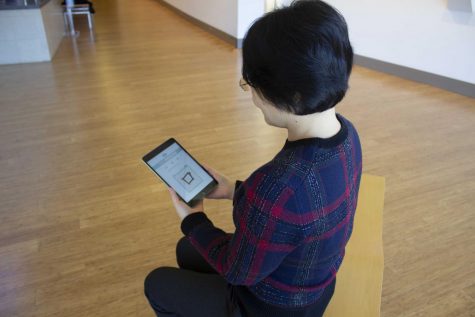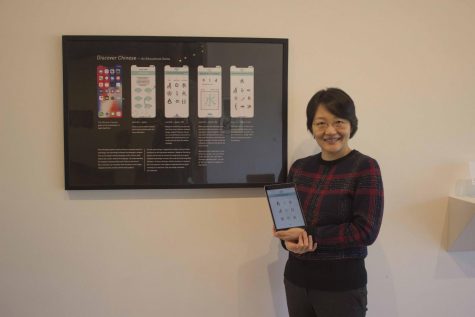Making language learning accessible
Professor creates app to help with learning Chinese

Associate Professor of Graphic Design Xinran Hu plays with her app “Discover Chinese.”
When Associate Professor of Graphic Design Xinran Hu decided she wanted her American-born daughter to learn Chinese, she struggled keeping her daughter interested in the many Chinese characters. Hu remembered being a child herself, learning the characters by writing the lines over and over until she memorized them. Frustrated, Hu began a two-year process of finding a better way to learn Chinese.
After nearly two years of research, design, testing and approval, Hu launched her app “Discover Chinese” on Dec. 2, 2018.
“I tried to find a new way, an interesting way to do it,” Hu said. “I targeted a simple, single component.”
Discover Chinese helps teach language learners more than 100 Chinese characters through six lessons. There is no background in Chinese needed to start. Hu said the app is unlike any textbook, and makes learning fun, reasonable and meaningful.
Chinese is an imagery-based language. Hu decided to use this as a way to teach through illustrations and images instead of using a textbook that requires learners to memorize the modern characters alone. Rather, users associate the Chinese characters with images relating to the words meaning.
“We have this psychology based cognization theory,” Hu said. “As a human being, it doesn’t matter what language you speak or what cultural background you have, our brain recognizes certain visual patterns. I thought ‘our brains respond this way, so how about I make this little game,’ and there’s one column of illustrations, the real thing, (and) the second column is that first word in Chinese, then the current Chinese.”
When using the app, users tap on their chosen lesson and are taken to a screen with three categories showing an image, the original Chinese symbol for the word and the modern character. Then users select one image from each category based off their similar design and see if they guessed the correct word.
After successfully matching the three together the app takes users to a new screen to practice writing the character.
“I feel even the way we learned is not the best way,” Hu said. “The research is all there. The linguist already did this research. It’s never been applied to the real word and learning. You need to bring to the real world into classroom learning. So I thought why not apply it to a learning game.”
Hu said she wanted to create a way of learning that was not taught to someone, but where the user has to learn and discover for themselves.
After the initial idea, Hu’s process involved a full year of research into the first symbols of Chinese and the modernized Chinese characters. Hu worked with linguist and other professors to check the accuracy of the early Chinese.
Next Hu said she had to create her first chapter. Limiting her to a certain amount of characters, Hu said she had to decide which characters would be the best to teach.
“I already know all of them,” Hu said. “So which part? You are designing a textbook. What should be the first chapter? That took me awhile.”
http://https://www.youtube.com/watch?v=Wxxlf8m5Sg8&feature=youtu.be
After researching and finding the best characters to teach a new learner, Hu worked with senior graphic design and illustration major, Betheny Swartzentruber, to create illustrations to go along with each word and help associate the way the characters looked.
Swartzentruber had previously shown interest in learning the Chinese language after rooming with an international student from Taiwan.
Swartzentruber said she began working on the illustrations at the start of 2018 and finished in November.
“Thinking about the illustrations, I really had to look into each of the Chinese characters. It was really highly imagery based on how the ancient Chinese symbols flow into the modern symbols and their meanings,” Swartzentruber said. “So I just had to break down each one into different elements and how they represented each one. I just had to see the similarities between the Chinese symbols and the objects they were meant to represent.”
As she began sketching, Swartzentruber said her style was too similar to the ancient symbols.
“I had to develop my own style so it wouldn’t be confusing,” Swartzentruber said. “The Chinese symbols themselves are more organic shaped, so I had to take that and give it more of a modern icon look, instead of painterly. I had to put a more modern twist on it so it wouldn’t be confused with the symbols that already existed.”
Swartzentruber said she relied on her previous art classes to complete the illustrations, especially the principles from her design classes like similarity and leveling and sharpening.
“I grew a lot as an illustrator because I had to push myself and keep trying, especially on the trickier ones whenever I got frustrated,” she said. “I had to find new solutions to make it so the person interacting with the app would be able to make the connections without it being too obvious or too confusing.”
“I was really excited to see the finalized versions because I think it really tied it all together,” Swartzentruber said. “Imagery is such an important part of Chinese. I hope that it will spark an interest towards the language and encourage people to pursue learning the language. And to just show the history of the language itself and just how important that is in each of the characters.”
After the design process was completed, Hu tested the app on students from the Chinese Academy of Southern Indiana and the university.

Associate Professor of Graphic Design Xinran Hu smiles with her app.
Sean McDicken helped test the app last year in Hu’s class as an extra project for the Honors Program. The senior graphic design major said he has been learning Japanese which has similar characters to that of Chinese.
“I was honored,” McDicken said. “It was really nice because I really do value communication a lot, and I think that the more people that we can communicate with and the more languages that we understand the better off the world will be.”
McDicken said it is important to show the original Chinese characters because it shows the transition of the language through time and how the past relates to the present symbol.
“I think the app is really interesting in the way that it helps people recognize Chinese characters,” McDicken said. “I think the teaching style is really effective because I feel there are a lot of people who are visual learners as well as those who learn through reading and writing. I think this caters to those who may not have a more traditional learning style.”
Hu said the app is growing beyond the university and Indiana, with downloads from Australia and France and nearly 20 downloads every week.
Hu encourages anyone to try out the app, hoping to receive feedback. If the app receives positive feedback in helping users learn the language, Hu hopes to create more lessons and characters for users to learn.
“If it works, I can come out with a second one,” Hu said. “If people think this method works then I’ll go further. For me, it’s an experiment. I just tried to help and see if this different approach to learning worked. I just want people to learn that this is not that hard. If you find an interesting way to learn it, then it’s not that hard.”
